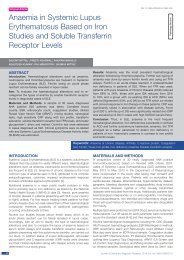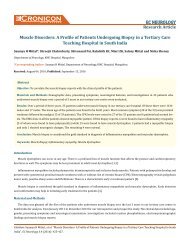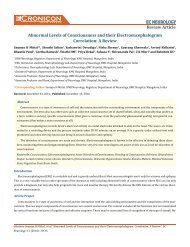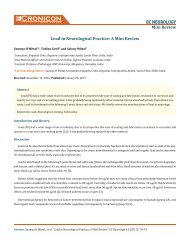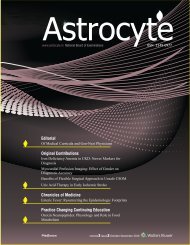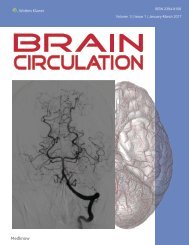Guillain–Barré syndrome A rare manifestation of Hansen’s ds disease
Create successful ePaper yourself
Turn your PDF publications into a flip-book with our unique Google optimized e-Paper software.
Neurology India<br />
Official Publication <strong>of</strong> the Neurological Society <strong>of</strong> India<br />
January-February 2017 / Vol 65 / Issue 1<br />
ISSN 0028-3886<br />
www.neurologyindia.com
Letters to Editor<br />
<strong>Guillain–Barré</strong> <strong>syndrome</strong>: A <strong>rare</strong> <strong>manifestation</strong> <strong>of</strong><br />
<strong>Hansen’s</strong> <strong>disease</strong><br />
Sir,<br />
<strong>Guillain–Barré</strong> (GB) <strong>syndrome</strong> was described by the French<br />
neurologists Guillain, Barre, and Strohl. It is an acute<br />
autoimmune polyradiculopathy that is characterized by<br />
progressive symmetrical muscle weakness. [1] The patients<br />
develop acute paralysis with areflexia. It is <strong>of</strong>ten preceded by<br />
infections such as Campylobacter jejuni, Mycoplasma pneumonia,<br />
Hemophilus influenza, cytomegalovirus, and Epstein‐Barr virus<br />
infections by at least 3 weeks. We report a case <strong>of</strong> a 45‐year‐old<br />
gentleman presenting with leprosy as a <strong>rare</strong> cause <strong>of</strong> GB<br />
<strong>syndrome</strong>.<br />
The patient presented to the hospital with complaints <strong>of</strong><br />
weakness affecting all 4 limbs since the last 5 days. The<br />
weakness was distal as well as proximal. The patient also<br />
turned out to be a case <strong>of</strong> <strong>Hansen’s</strong> <strong>disease</strong>. This was<br />
detected approximately 2 months before his presentation<br />
to the hospital as a result <strong>of</strong> ulceration <strong>of</strong> the foot. He was<br />
<strong>of</strong>f treatment because <strong>of</strong> gastric ulcerations. There was no<br />
other significant medical history. The patient presented<br />
with normal higher mental functions and was found to have<br />
a power <strong>of</strong> 2 <strong>of</strong> 5 proximally and 3 <strong>of</strong> 5 distally. There was<br />
generalized areflexia with bilateral flexor plantar response.<br />
The sensory loss was restricted to anesthetic patches on the<br />
back and few patches on the trunk. The patient had palpable<br />
nerves—bilateral radial and ulnar nerves. The foot lesions<br />
had healed in the left foot; however, they persisted in the<br />
right foot.<br />
The patient was evaluated for nerve conduction velocity (NCV),<br />
which was suggestive <strong>of</strong> GB <strong>syndrome</strong>. He was taken up for<br />
sural nerve biopsy which showed features that were suggestive<br />
<strong>of</strong> <strong>Hansen’s</strong> <strong>disease</strong>. The slides were reviewed at 2 teaching<br />
institutes and yielded consistent results. Other investigations<br />
and possible causes <strong>of</strong> neuropathy (malarial parasite, hepatitis<br />
B surface antigen, human immunodeficiency virus (HIV),<br />
rheumatoid arthritis factor, antinuclear antibody, C3, elevated<br />
sugars, and thyroid levels) were negative.<br />
The patient was deteriorating rapidly, and therefore, a course<br />
<strong>of</strong> intravenous immunoglobulins (IvIg) was initiated. Dapsone<br />
was also initiated. After therapy with IvIg, the patient improved<br />
rapidly.<br />
GB <strong>syndrome</strong> is a neuropathic condition that is characterized<br />
primarily by progressive symmetrical weakness and areflexia.<br />
Symptoms usually peak at 4 weeks. [1] Several infections<br />
affecting predominantly the respiratory and the gastrointestinal<br />
tract are implicated in the development <strong>of</strong> this <strong>syndrome</strong>. [1,2]<br />
While not commonly implicated, vaccination is <strong>rare</strong>ly known to<br />
be associated with the <strong>syndrome</strong>. Influenza, swine flu, tetanus,<br />
hepatitis, and more recently, influenza A vaccination are few<br />
<strong>of</strong> the examples that may cause the <strong>syndrome</strong>. [1,2]<br />
Some <strong>of</strong> the differential diagnosis <strong>of</strong> the <strong>syndrome</strong> include<br />
brainstem involvement, spinal cord affliction, muscle and<br />
neuromuscular disorders, and polyneuropathies such as<br />
chronic inflammatory demyelinating polyneuropathy. The<br />
latter is acquired symmetrical, proximal and distal limb<br />
weakness and sensory disturbances progressing over 2 months.<br />
It is also known to be caused by infective agents such as HIV,<br />
hepatitis C, and <strong>Hansen’s</strong> <strong>disease</strong>. [1,3]<br />
Leprosy is a chronic infection that is caused by Mycobacterium<br />
leprae. The organism was identified in 1873 by Hansen. It is a<br />
neuropathy itself that affects the nerve trunks and cutaneous<br />
nerve endings leading to sensory, motor, and autonomic<br />
neuropathies. Small fiber neuropathies occur initially whereas<br />
the large fiber neuropathies occur late. The most common<br />
associations <strong>of</strong> <strong>Hansen’s</strong> <strong>disease</strong> are with classical leprosy<br />
neuropathy, pure neuritic leprosy, reactional leprosy neuritis,<br />
painful small fiber neuropathy, leprosy late onset neuropathy,<br />
autonomic neuropathy, and arthritic leprosy. [4‐6]<br />
As <strong>of</strong> now, it has been hypothesized that lepra reaction may<br />
lead to the exposure <strong>of</strong> neural antigens. These antigens may<br />
lead to autoimmune reaction, thereby causing GB <strong>syndrome</strong>. [7,8]<br />
Rarely, cases have been known that present as GB <strong>syndrome</strong><br />
without any evidence <strong>of</strong> lepra reaction. [9] To conclude, we<br />
present a <strong>rare</strong> case <strong>of</strong> GB <strong>syndrome</strong> that was caused by<br />
<strong>Hansen’s</strong> <strong>disease</strong> with no evidence <strong>of</strong> lepra reaction. To the<br />
best <strong>of</strong> our knowledge, there have been only 1 report <strong>of</strong> similar<br />
presentation reported in the past decade.<br />
Financial support and sponsorship<br />
Nil.<br />
Conflicts <strong>of</strong> interest<br />
There are no conflicts <strong>of</strong> interest.<br />
Saumya H Mittal, K C Rakshith, Z K Misri,<br />
Shivanand Pai, Nisha Shenoy<br />
Department <strong>of</strong> Neurology, KMC Hospital, Mangalore,<br />
Karnataka, India<br />
Address for correspondence:<br />
Dr. Saumya H Mittal,<br />
Department <strong>of</strong> Neurology, KMC Hospital, Mangalore,<br />
Karnataka, India.<br />
E‐mail: saumyamittal1@gmail.com<br />
References<br />
1. Walling AD, Dickson G. Guillain‐Barré <strong>syndrome</strong>. Am Fam<br />
Physician 2013;87:191‐7.<br />
2. van Doorn PA1, Ruts L, Jacobs BC. Clinical features, pathogenesis,<br />
and treatment <strong>of</strong> Guillain‐Barré <strong>syndrome</strong>. Lancet Neurol<br />
2008;7:939‐50.<br />
3. Köller H, Kieseier BC, Jander S, Hartung HP. Chronic inflammatory<br />
demyelinating polyneuropathy. N Engl J Med 2005;352:1343‐56.<br />
4. Nascimento OJ. Leprosy neuropathy: Clinical presentations. Arq<br />
Neuropsiquiatr 2013;71:661‐6.<br />
Neurology India | January-February 2017 | Vol 65 | Issue 1 179
Letters to Editor<br />
5. Cardoso Fde M, De Freitas MR, Escada TM, Nevares MT,<br />
Nascimento OJ. Late onset neuropathy in leprosy patients released<br />
from treatment: Not all due to reactions? Lepr Rev 2013;84:128‐35.<br />
6. Cabalar M, Yayla V, Ulutas S, Senadim S, Oktar AC. The clinical and<br />
neurophysiological study <strong>of</strong> leprosy. Pak J Med Sci 2014;30:501‐6.<br />
7. Grover C, Kubba S, Nanda S, Kumar V, Reddy BS. Leprosy with<br />
Guillain Barre <strong>syndrome</strong>: A new neurologic <strong>manifestation</strong>? J<br />
Dermatol 2004;31:119‐33.<br />
8. Rai VM, Shenoi S, Rao SN. Guillain Barré Syndrome like<br />
presentation in borderline leprosy with type 2 reaction. Dermatol<br />
Online J 2006;12:21.<br />
9. Kumar S. Guillain‐Barre <strong>syndrome</strong> in leprosy patients. Indian J Lepr<br />
2005;77:162‐8.<br />
This is an open access article distributed under the terms <strong>of</strong> the Creative Commons<br />
Attribution‐NonCommercial‐ShareAlike 3.0 License, which allows others to remix, tweak, and<br />
build upon the work non‐commercially, as long as the author is credited and the new creations<br />
are licensed under the identical terms.<br />
Website:<br />
www.neurologyindia.com<br />
DOI:<br />
10.4103/0028-3886.198191<br />
PMID:<br />
xxxx<br />
Access this article online<br />
Quick Response Code<br />
How to cite this article: Mittal SH, Rakshith KC, Misri ZK, Pai S,<br />
Shenoy N. <strong>Guillain–Barré</strong> <strong>syndrome</strong>: A <strong>rare</strong> <strong>manifestation</strong> <strong>of</strong> Hansen's<br />
<strong>disease</strong>. Neurol India 2017;65:179-80.<br />
© 2017 Neurology India, Neurological Society <strong>of</strong> India | Published by Wolters Kluwer - Medknow<br />
Novel SCN8A mutation in a girl with refractory<br />
seizures and autistic features<br />
Sir,<br />
A 4‐year‐old girl presented with speech delay and refractory<br />
seizures. She had no adverse perinatal events, had normal<br />
motor milestones, and could speak only a few bisyllables.<br />
She had seizures since 4 months <strong>of</strong> age. Initially, she had<br />
generalized tonic–clonic seizures (2–3 episodes/week) and<br />
required multiple anticonvulsant drugs (phenytoin, valproate,<br />
lamotrigine, clobazam, and levetiracetam). After 14 months <strong>of</strong><br />
age, she experienced nocturnal tonic seizures (2–3 times/week)<br />
and atypical absences (2–3/day), which continued until her<br />
admission to our hospital. The seizures were only occasionally<br />
associated with fever. In addition to having seizures, she<br />
had autistic features (Childhood Autism Rating Scale score<br />
<strong>of</strong> 32). Her physical examination was unremarkable. Magnetic<br />
resonance imaging (MRI) <strong>of</strong> the brain was normal. Interictal<br />
electroencephalogram (EEG) showed a slow background<br />
activity with right frontopolar spike‐wave discharges.<br />
Karyotype, array comparative genomic hybridization, plasma<br />
acylcarnitine pr<strong>of</strong>ile, and urine organic aci<strong>ds</strong> were normal. Next<br />
generation sequencing for epilepsy genes [Table 1] revealed a<br />
novel pathogenic heterozygous missense mutation (c.4214C>A;<br />
p.Ala1405Asp) in the exon 22 <strong>of</strong> the SCN8A gene. Both the<br />
parents were negative for this variant. She was again started<br />
on phenytoin with resolution <strong>of</strong> tonic seizures, persistence <strong>of</strong><br />
atypical absences, and appearance <strong>of</strong> daily head‐drops. She was<br />
started on modified Atkins diet. However, it had to be stopped<br />
after 25 days in view <strong>of</strong> poor compliance and oral acceptance<br />
by the child. Behavioural therapy was initiated and genetic<br />
counselling was done.<br />
Mutations in SCN8A, encoding one <strong>of</strong> the main voltage‐gated<br />
sodium channel subunits (Nav1.6) in the brain, have been<br />
recently described in patients with severe epilepsy and the<br />
phenotype is still evolving. [1,2] Seventeen patients with de novo<br />
heterozygous mutations <strong>of</strong> SCN8A were recently reported.<br />
[2]<br />
The phenotype comprised variable intellectual disability,<br />
drug‐refractory epilepsy, autistic features, and prominent<br />
motor <strong>manifestation</strong>s (hypotonia, dystonia, hyperreflexia, and<br />
ataxia). The mean age at the onset <strong>of</strong> seizures was 5 months<br />
and the reported seizure types included focal, tonic, clonic,<br />
myoclonic, atypical absence seizures, epileptic spasms, and<br />
febrile seizures. Thus, the genetic testing for SCN8A should<br />
be considered in children with unclassified severe epilepsy.<br />
This may have a therapeutic implication. Four patients with a<br />
missense SCN8A mutation and epilepsy were reported to have<br />
a remarkably good response on high doses <strong>of</strong> phenytoin, and<br />
loss <strong>of</strong> seizure control when the phenytoin medication was<br />
reduced. [3] Our patient showed resolution <strong>of</strong> tonic seizures with<br />
phenytoin; however, the other seizure types were unaffected.<br />
Due to the recent advances in targeted next‐generation<br />
sequencing panels for epileptic encephalopathy/epilepsy,<br />
the diagnostic yield for an underlying genetic abnormality<br />
has increased in patients with epileptic encephalopathy. The<br />
diagnostic yiel<strong>ds</strong> have been reported to be between 10 and 48.5%<br />
in the literature for the 35 to 265 gene panels. [4] This technique<br />
has helped us to achieve a diagnosis in the present case.<br />
Table 1: Next Generation Sequencing for epilepsy gene panel<br />
ADSL, PMM2, ARX, PNKP, SCN2A, PLCB1, SCN8A, KCNT1,<br />
GABRA1, GRIN2B, CDKL5, SLC25A22, STXBP1, SPTAN1, SCN1A,<br />
KCNQ2, PCDH19, ARHGEF9, GABRG2, GABRB3, CACNA1H,<br />
GRIN2A, SCN1B, GABRD, SCN9A, CACNB4, CLCN2, SLC2A1,<br />
EFHC1, ALDH7A1, CHD2, SCN2A, KCNQ3, MECP2, MEF2C,<br />
FOXG1, CHRNA4, CHRNB2, CHRNA2, DEPDC5, CNTNAP2, LGI1,<br />
CPA6, KCNMA1, SRPX2, KCNJ10, PNPO, SLC9A6 (48)<br />
180 Neurology India | January-February 2017 | Vol 65 | Issue 1




